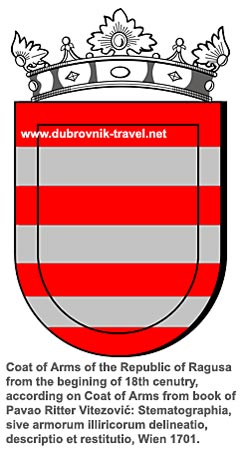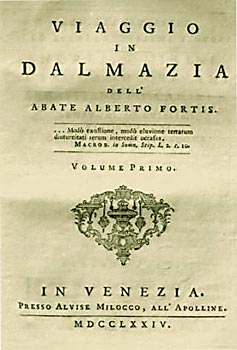Dubrovnik as the Focal Point of Dalmatian Enlightement
 The developed urbanity, international connections and outward-looking adventurous sophistication of the Dubrovnik elite meant that the borderland city would be directly exposed to the major cultural movement in early modern Europe. The 18th century European Enlightenment began as a cultural movement expressing the progressive bourgeoisie’s criticism of dogmatic rule and focus on critical thinking and social change. This had been present in Dubrovnik since the Renaissance as the activities and writings of Marin Drzić illustrate.
The developed urbanity, international connections and outward-looking adventurous sophistication of the Dubrovnik elite meant that the borderland city would be directly exposed to the major cultural movement in early modern Europe. The 18th century European Enlightenment began as a cultural movement expressing the progressive bourgeoisie’s criticism of dogmatic rule and focus on critical thinking and social change. This had been present in Dubrovnik since the Renaissance as the activities and writings of Marin Drzić illustrate.
Dubrovnik’s place in the Enlightenment’s public sphere can be seen by the fact that Montesquieu’s ‘Spirit of the laws’ mentions the city. Dubrovnik was also mentioned in the various editions of the famous French Encyclopédie. In Switzerland, Dubrovnik is praised as a model of Enlightenment’s doctrine in the book ‘Trattato degli interessi e dei doveri di un repubblicano’.
The Enlightenment in Dubrovnik occurred at the same time as the Enlightenment in continental Croatia. The latter was influenced by the Hapsburg Emperor Joseph II. Due to better developed communications within the Adriatic, Dubrovnik was exposed to the Enlightenment primarily from the Apennine peninsula i.e. Venice, Padua but also Switzerland and France. Indeed, apart from the regular university placements in Padua, Dubrovnik’s brightest were educated in European universities such as the Sorbonne and Salamanca. Consequently, the progressive credentials of the French educated elite were often at odds with the more conservative nature of the Spanish educated elite. In the Dubrovnik assembly of nobles, the opposing currents of political thought eventually became known as the Sorbonesi (Sorbonne graduates) and the Salamancasi (graduates of Salamanca).
The different parts of Croatia experienced the Enlightenment in different ways. Within continental Croatia, the Enlightenment was supported by the reformist nature of the Hapsburg emperor such as Maria Theresa and Joseph II. In Dalmatia, the Venetian empire was not intensively involved in social reforms, whilst in Dubrovnik the Enlightenment is expressed mostly through hesitant, aristocratic writings in newspapers. Dubrovnik’s leading role in the Dalmatian Enlightenment can be attributed to its relative avoidance of the consequences of the wars with the Ottoman Empire that had impoverished large parts of Dalmatia.
The Dalmatian Enlightenment itself was supported by young members of the aristocracy, their bourgeois contemporaries and some parts of the clergy, in particular the Franciscan order, who maintained close links with the people. In many coastal towns but in particular in Dubrovnik, members of the aristocracy and the urban bourgeoisie returned from their studies in European universities as followers of Jean Jacques-Rousseau, imbued with novel, progressive ideas of the Enlightenment though their readings of the French Encyclopaedists and to a certain extent partisans of French revolutionary ideas.
Dubrovnik’s proximity to the borderlands, with its exotic, pre-romanticist Morlach inhabitants was attractive to contemporary travellers. They were seen by Europeans as embodying the ‘natural state’ of Rousseau’s uncorrupted man in the state of nature. This made Dalmatia and Dubrovnik’s in particular a target for people looking for ‘man in his natural state’.
 In 1776, the Venetian Alberto Fortis undertook an expedition all over the Dalmatian coast where he memorably describes the inhabitants in his ‘Journey through Dalmatia’. Fortis’ description of Dubrovnik is overwhelmingly positive. He praises the ‘consistency and erudition of the Dubrovnik people’ which he contrasts with the ‘un-free and neglected Dalmatia under Venice.’ Observing the people and their behaviour Fortis notes that the ‘nobles have a developed level of culture which could be found in the most Enlightened Italian towns, without their inconvenience and vice.’ Towards the Dubrovnik authorities, Fortis is sometimes ironic and teasing, calling them crazy and comparing them to the highland Morrlachs.
In 1776, the Venetian Alberto Fortis undertook an expedition all over the Dalmatian coast where he memorably describes the inhabitants in his ‘Journey through Dalmatia’. Fortis’ description of Dubrovnik is overwhelmingly positive. He praises the ‘consistency and erudition of the Dubrovnik people’ which he contrasts with the ‘un-free and neglected Dalmatia under Venice.’ Observing the people and their behaviour Fortis notes that the ‘nobles have a developed level of culture which could be found in the most Enlightened Italian towns, without their inconvenience and vice.’ Towards the Dubrovnik authorities, Fortis is sometimes ironic and teasing, calling them crazy and comparing them to the highland Morrlachs.
Translated into many languages and a revealing early example of travel writing and cultural history, Travels into Dalmatia played an important role in bringing the Dalmatian culture to the attention of Europe during the rise of Romantic notions about folklore.
Literary works published in Dalmatia at this time point to the linguistic element becoming a significant feature of nascent national pride. In one case, the military chaplain Filip Grabovac (1687-1749) would be arrested and censored by the Venetian authorities for his work ‘Cvit ragovora naroda I jezika iliričkoga aliti rvackoga’ – (The flowering conversation of the Croatian-illyrian people). Published in 1747, this work was censored for ‘insulting the Venetian gentry’.
Need Entry Tickets to Town Walls? Buy Now
Within Dubrovnik, many of its citizens were familiar with the developments in the Enlightenment through consummation of seminal publications in the important parts of Europe. This included works by contemporary European Enlightenment figures and philosophes, with a particular emphasis on French rationalists. Despite censorship and numerous trials, the private book collections testify to the presence of works by Montesquieu, Voltaire, Diderot, Helvetius, David Hume and John Locke amongst others. As the theoretical foundations of the French and the American revolutions, the presence of the books encouraged the population of Dubrovnik to engage in theoretical debates of necessary structural reforms within the city.
The Dubrovnik authorities reacted to the Enlightenment in different ways. Censorship measures included the 1782 ban on the discussion of religious questions and the 1783 ban on theatre performances. Despite this, Dubrovnik was one of the first states to recognise the secessionist states in the USA and sent its boats into New York harbours. One of the first people to consider moving to the USA was one of Dubrovnik’s greatest polymaths, Rudjer Bosković. (Vicko Marelic)
Popular routes: Split to Dubrovnik, Dubrovnik to Split, Hvar to Dubrovnik, Dubrovnik to Hvar
Dubrovnik History Articles
- The History of Dubrovnik – an introduction
- The foundation in the Dark Ages – balancing on a borderland
- Early medieval times
- The beginning of trade
- Trade Agreements with Balkan Countries
- Breaking Away From Venice and Territorial Expansion
- The Ottomans Arrive
- Dubrovnik’s Golden Age
- Dubrovnik as the Focal Point of Dalmatian Enlightment
- Rudjer Boskovic – Dubrovnik’s Shining Example of the Enlightement
- The Jews of Dubrovnik

 Subscribe
Subscribe